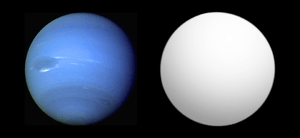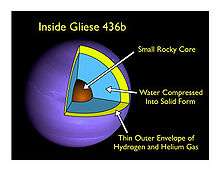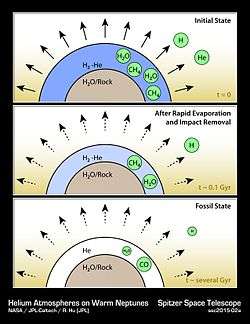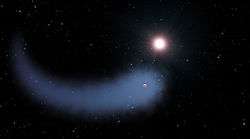Gliese 436 b
| Exoplanet | List of exoplanets | |
|---|---|---|
 | ||
| Parent star | ||
| Star | Gliese 436 | |
| Constellation | Leo | |
| Right ascension | (α) | 11h 42m 11.0941s[1] |
| Declination | (δ) | +26° 42′ 23.652″[1] |
| Apparent magnitude | (mV) | 10.68 |
| Distance | 33.4 ± 0.8 ly (10.2 ± 0.2 pc) | |
| Spectral type | M2.5 V[1] | |
| Mass | (m) | 0.41 ± 0.05 M☉ |
| Radius | (r) | 0.42 R☉ |
| Temperature | (T) | 3318 K |
| Metallicity | [Fe/H] | -0.32 |
| Age | 7.41–11.05[2] Gyr | |
| Orbital elements | ||
| Semi-major axis | (a) | 0.0291±0.0004[3] AU (4.35 Gm) |
| 2.85 mas | ||
| Periastron | (q) | 0.0247 AU (3.70 Gm) |
| Apastron | (Q) | 0.0335 AU (5.01 Gm) |
| Eccentricity | (e) | 0.150±0.012[3] |
| Orbital period | (P) | 2.643904±0.000005[4] d (0.00723849 y) |
| (63.4537 h) | ||
| Inclination | (i) | 85.8+0.21 −0.25[4]° |
| Argument of periastron |
(ω) | 351±1.2° |
| Time of periastron | (T0) | 2,451,551.716 ±0.01 JD |
| Semi-amplitude | (K) | 18.68±0.8 m/s |
| Physical characteristics | ||
| Mass | (m) | 22.2±1.0[3] M⊕ |
| Radius | (r) | 4.327±0.183[3][5] R⊕ |
| Stellar flux | (F⊙) | 29.5 ⊕ |
| Density | (ρ) | 1.51 g cm−3 |
| Surface gravity | (g) | 1.18 g |
| Temperature | (T) | 712±36[3] |
| Discovery information | ||
| Discovery date | August 31, 2004 | |
| Discoverer(s) | Butler, Vogt, Marcy et al. | |
| Discovery method | Radial velocity, Transit | |
| Discovery site | California, USA | |
| Discovery status | Published | |
| Other designations | ||
| Ross 905 b, GJ 436 b,[6] LTT 13213 b, GCTP 2704.10 b, LHS 310, AC+27:28217 b, Vyssotsky 616 b, HIP 57087 b, GEN# +9.80120068 b, LP 319-75 b, G 121-7 b, LSPM J1142+2642 b, 1RXS J114211.9+264328 b, ASCC 683818 b, G 147-68 b, UCAC2 41198281 b, BPS BS 15625-0002 b, G 120-68 b, 2MASS J11421096+2642251 b, USNO-B1.0 1167-00204205 b, CSI+27-11394 b, MCC 616 b, VVO 171 b, CSI+27-11395 b, HIC 57087 b, NLTT 28288 b, Zkh 164 b, CSI+26-11395 b, [RHG95] 1830 b, GCRV 7104 b, LFT 838 b, PM 11395+2700 b | ||
| Database references | ||
| Extrasolar Planets Encyclopaedia | data | |
| SIMBAD | data | |
| Exoplanet Archive | data | |
| Open Exoplanet Catalogue | data | |
Gliese 436 b /ˈɡliːzə/ (sometimes called GJ 436 b[7]) is a Neptune-sized exoplanet orbiting the red dwarf Gliese 436.[8] It was the first hot Neptune discovered with certainty (in 2007) and was among the smallest known transiting planets in mass and radius, until the much smaller Kepler exoplanet discoveries started coming in by 2010.
In December 2013, NASA reported that clouds may have been detected in the atmosphere of GJ 436 b.[9][10][11][12]
Discovery
Gliese 436 b was discovered in August 2004 by R. Paul Butler and Geoffrey Marcy of the Carnegie Institute of Washington and University of California, Berkeley, respectively, using the radial velocity method. Together with 55 Cancri e, it was then the first of a new class of planets with a minimum mass (M sini) similar to Neptune.
The planet was recorded to transit its star by an automatic process at NMSU on January 11, 2005, but this event went unheeded at the time.[13] In 2007, Gillon led a team which observed the transit, grazing the stellar disc relative to Earth. Transit observations led to the determination of Gliese 436 b's exact mass and radius, both of which are very similar to Neptune. Gliese 436 b then became the smallest known transiting extrasolar planet. The planet is about 4000 km larger in diameter than Uranus and 5000 km larger than Neptune and a bit more massive. Gliese 436b (also known as GJ 436b) orbits its star at a distance of 4,000,000 km or 15 times closer than Mercury's average distance from the Sun.
Physical characteristics


The planet's surface temperature is estimated from measurements taken as it passes behind the star to be 712 K (439 °C).[3] This temperature is significantly higher than would be expected if the planet were only heated by radiation from its star (which had been, in a Reuters article from a month prior to this measurement, estimated at 520 K). Whatever energy tidal effects deliver to the planet, it does not affect its temperature significantly.[14] A greenhouse effect could raise the temperature to much higher degrees than the predicted 520–620 K.[15]
Its main constituent was initially predicted to be hot "ice" in various exotic high-pressure forms,[15][16] which would remain solid despite the high temperatures, because of the planet's gravity.[17] The planet could have formed further from its current position, as a gas giant, and migrated inwards with the other gas giants. As it arrived in range, the star would have blown off the planet's hydrogen layer via coronal mass ejection.[18]
However, when the radius became better known, ice alone was not enough to account for it. An outer layer of hydrogen and helium up to ten percent in mass would be needed on top of the ice to account for the observed planetary radius.[3][4] This obviates the need for an ice core. Alternatively, the planet may be a super-earth.[19]
Observations of the planet's brightness temperature with the Spitzer Space Telescope suggest a possible thermochemical disequilibrium in the atmosphere of this exoplanet. Results published in Nature suggest that Gliese 436b's dayside atmosphere is abundant in CO and deficient in methane (CH4) by a factor of ~7,000. This result is unexpected because, based on current models at this temperature, the atmospheric carbon should prefer CH4 over CO.[20][21][22][23]
In June 2015, scientists reported that the atmosphere of Gliese 436 b was evaporating,[24] resulting in a giant cloud around the planet and, due to radiation from the host star, a long trailing tail 14×106 km (9×106 mi) long.[25]

Orbital characteristics
One orbit around the star takes only about 2 days, 15.5 hours. Gliese 436 b's orbit is likely misaligned with its star's rotation.[22]
The eccentricity of Gliese 436 b's orbit is inconsistent with models of planetary system evolution. To have maintained its eccentricity over time requires that it be accompanied by another planet.[3][27]
See also
References
- 1 2 3 "LHS 310". Simbad. Centre de Données astronomiques de Strasbourg. Retrieved 2007-11-28.
- ↑ Saffe, C.; Gómez, M.; Chavero, C. (2006). "On the Ages of Exoplanet Host Stars". Astronomy & Astrophysics 443 (2): 609–626. arXiv:astro-ph/0510092. Bibcode:2005A&A...443..609S. doi:10.1051/0004-6361:20053452.
- 1 2 3 4 5 6 7 8 Drake Deming; Joseph Harrington; Gregory Laughlin; Sara Seager; Navarro, Sarah B.; Bowman, William C.; Karen Horning (2007). "Spitzer Transit and Secondary Eclipse Photometry of GJ 436b". The Astrophysical Journal 667 (2): L199–L202. arXiv:0707.2778. Bibcode:2007ApJ...667L.199D. doi:10.1086/522496.
- 1 2 3 Bean, J.L.; et al. (2008). "A Hubble Space Telescope transit light curve for GJ 436b". Astronomy & Astrophysics 486: 1039–1046. arXiv:0806.0851. Bibcode:2008A&A...486.1039B. doi:10.1051/0004-6361:200810013.
- ↑ Confirmed, Pont, F.; Gilliland, R. L.; Knutson, H.; Holman, M.; Charbonneau, D. (2008). "Transit infrared spectroscopy of the hot neptune around GJ 436 with the Hubble Space Telescope". Monthly Notices of the Royal Astronomical Society: Letters 393: L6–L10. arXiv:0810.5731. Bibcode:2009MNRAS.393L...6P. doi:10.1111/j.1745-3933.2008.00582.x.
- ↑ Maness; Marcy, G. W.; Ford, E. B.; Hauschildt, P. H.; Shreve, A. T.; Basri, G. B.; Butler, R. P.; Vogt, S. S. (2006). "The M Dwarf GJ 436 and its Neptune-Mass Planet". Submitted to Publications of the Astronomical Society of the Pacific 119 (851): 90–101. arXiv:astro-ph/0608260. Bibcode:2007PASP..119...90M. doi:10.1086/510689.
- ↑ Beust,Hervé; et al. (August 1, 2012). "Dynamical evolution of the Gliese 436 planetary system - Kozai migration as a potential source for Gliese 436b's eccentricity". arXiv 545: A88. arXiv:1208.0237. Bibcode:2012A&A...545A..88B. doi:10.1051/0004-6361/201219183. Retrieved January 2, 2014.
- ↑ Butler; Vogt, Steven S.; Marcy, Geoffrey W.; Fischer, Debra A.; Wright, Jason T.; Henry, Gregory W.; Laughlin, Greg; Lissauer, Jack J. (2004). "A Neptune-Mass Planet Orbiting the Nearby M Dwarf GJ 436". The Astrophysical Journal 617 (1): 580–588. arXiv:astro-ph/0408587. Bibcode:2004ApJ...617..580B. doi:10.1086/425173.
- ↑ Harrington, J.D.; Weaver, Donna; Villard, Ray (December 31, 2013). "Release 13-383 - NASA's Hubble Sees Cloudy Super-Worlds With Chance for More Clouds". NASA. Retrieved January 1, 2014.
- ↑ Moses, Julianne (January 1, 2014). "Extrasolar planets: Cloudy with a chance of dustballs". Nature 505 (7481): 31–32. Bibcode:2014Natur.505...31M. doi:10.1038/505031a. Retrieved January 1, 2014.
- ↑ Knutson, Heather; et al. (January 1, 2014). "A featureless transmission spectrum for the Neptune-mass exoplanet GJ 436b". Nature 505 (7481): 66–68. arXiv:1401.3350. Bibcode:2014Natur.505...66K. doi:10.1038/nature12887. Retrieved January 1, 2014.
- ↑ Kreidberg, Laura; et al. (January 1, 2014). "Clouds in the atmosphere of the super-Earth exoplanet GJ 1214b". Nature 505 (7481): 69–72. arXiv:1401.0022. Bibcode:2014Natur.505...69K. doi:10.1038/nature12888. Retrieved January 1, 2014.
- ↑ Coughlin, Jeffrey L.; Stringfellow, Guy S.; Becker, Andrew C.; Mercedes Lopez-Morales; Fabio Mezzalira; Tom Krajci (2008). "New observations and a possible detection of parameter variations in the transits of Gliese 436b". The Astrophysical Journal 689 (2): L149–L152. arXiv:0809.1664. Bibcode:2008ApJ...689L.149C. doi:10.1086/595822.
- ↑ Brian Jackson; Richard Greenberg; Rory Barnes (2008). "Tidal Heating of Extra-Solar Planets". The Astrophysical Journal 681 (2): 1631–1638. arXiv:0803.0026. Bibcode:2008ApJ...681.1631J. doi:10.1086/587641.
- 1 2 M. Gillon; et al. (2007). "Detection of transits of the nearby hot Neptune GJ 436 b" (PDF). Astronomy and Astrophysics 472 (2): L13–L16. arXiv:0705.2219. Bibcode:2007A&A...472L..13G. doi:10.1051/0004-6361:20077799.
- ↑ Shiga, David (6 May 2007). "Strange alien world made of "hot ice"". New Scientist. Retrieved 2007-05-16.
- ↑ Fox, Maggie (May 16, 2007). "Hot "ice" may cover recently discovered planet". Science News (Scientific American.com). Retrieved 2008-08-06.
- ↑ H. Lammer; et al. (2007). "The impact of nonthermal loss processes on planet masses from Neptunes to Jupiters" (PDF). Geophysical Research Abstracts 9 (07850). By analogy with Gliese 876 d.
- ↑ E. R. Adams, S. Seager, and L. Elkins-Tanton (February 2008). "Ocean Planet or Thick Atmosphere: On the Mass-Radius Relationship for Solid Exoplanets with Massive Atmospheres". The Astrophysical Journal 673 (2): 1160–1164. arXiv:0710.4941. Bibcode:2008ApJ...673.1160A. doi:10.1086/524925.
- ↑ "Possible thermochemical disequilibrium in the atmosphere of the exoplanet GJ 436b". Nature 464 (7292): 1161–1164. 22 April 2010. arXiv:1010.4591. Bibcode:2010Natur.464.1161S. doi:10.1038/nature09013. PMID 20414304.
- ↑ GJ436b - Where's the methane? Planetary Sciences Group at the University of Central Florida, Orlando
- 1 2 Knutson, Heather A. (2011). "A Spitzer Transmission Spectrum for the Exoplanet GJ 436b". Astrophysical Journal. 735, 27: 27. arXiv:1104.2901. Bibcode:2011ApJ...735...27K. doi:10.1088/0004-637X/735/1/27.
- ↑ LINE, Michael R.; VASISHT, Gautam; CHEN, Pin; ANGERHAUSEN, D.; YANG, Yuk L. (2011). "Thermochemical and Photochemical Kinetics in Cooler Hydrogen Dominated Extrasolar Planets". Astrophysical Journal. 738, 32: 32. arXiv:1104.3183. Bibcode:2011ApJ...738...32L. doi:10.1088/0004-637X/738/1/32., abstract in the arXiv titled "Thermochemistry and Photochemistry in Cooler Hydrogen Dominated Extrasolar Planets: The Case of GJ436b"
- ↑ D. Ehrenreich, V. Bourrier, P. Wheatley, A. Lecavelier des Etangs, G. Hébrard, S. Udry, X. Bonfils, X. Delfosse, J.-M. Désert, D. K. Sing, and A. Vidal-Madjar (25 June 2015). "A Giant Comet-like Cloud of Hydrogen Escaping from the warm Neptune-mass Exoplanet GJ 436b". Nature 522: 459–461. arXiv:1506.07541. Bibcode:2015Natur.522..459E. doi:10.1038/nature14501.
- ↑ Bhanoo, Sindya N. (25 June 2015). "A Planet with a Tail Nine Million Miles Long". New York Times. Retrieved 25 June 2015.
- ↑ "Hubble sees atmosphere being stripped from Neptune-sized exoplanet". Retrieved 25 June 2015.
- ↑ Bean, Jacob L.; Andreas Seifahrt (2008). "Observational Consequences of the Recently Proposed Super-Earth Orbiting GJ436". arXiv:0806.3270 [astro-ph].
Selected media articles
| Wikinews has related news: Recently discovered planet may contain 'hot ice' |
- How Do Artists Portray Exoplanets They've Never Seen? 4/9, Scientific American October 2, 2007.
- Astronomers Detect Shadow Of Water World In Front Of Nearby Star (from Science Daily).
External links
![]() Media related to Gliese 436 b at Wikimedia Commons
Media related to Gliese 436 b at Wikimedia Commons
Coordinates: ![]() 11h 42m 11.0941s, +26° 42′ 23.652″
11h 42m 11.0941s, +26° 42′ 23.652″
| ||||||||||||||||||||||||||||||||||||||||||||||||||||||||||||||||||||||||||||